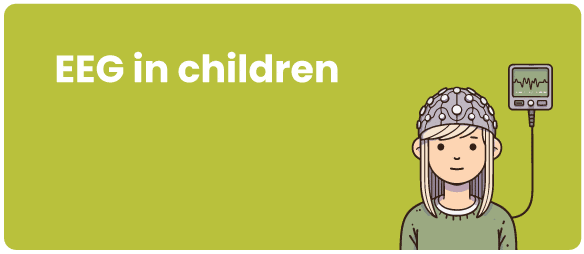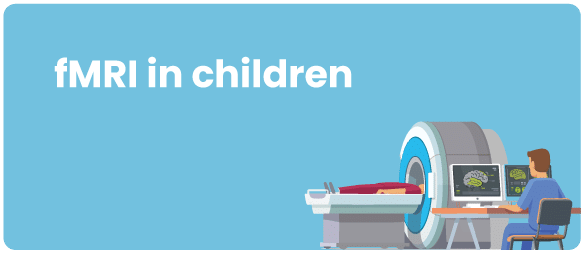Brain research in children
Why this research?
Why do we investigate reading and dyslexia in children?
Children show large individual differences in how easily they learn to read. In the Netherlands, for instance, one out of every twenty children faces severe reading problems due to dyslexia. Currently, diagnosis and intervention only take place after it is clear that a child’s reading level does not improve sufficiently with standard reading instruction. By then the child is around 8-9 years old, when reading reading problems have accumulated, often leading to lower self-confidence.
The goal of our research projects Leeskans and Leeswinst is to improve early prediction of reading difficulties so that in the future all children receive the right support from the start of learning to read. We are developing a learning task for early prediction, where young children learn letters from a made-up language.
Within Project Leeswinst, we use the learning task while measuring brain activity. We look at how children learn the letters and how their brains change during this process. For early prediction, it is important not only to understand how this learning process looks in children starting to learn to read but also in older children with and without a dyslexia diagnosis.
The Leeswinst Project currently consists of two sub-studies:
- EEG measurements in children aged 5-7 years (Amsterdam, Amersfoort, and Maastricht)
- fMRI scans in children aged 8-12 years with and without dyslexia (Maastricht)
You can read more about Project Leeskans on the page ‘early prediction of reading difficulties‘
Do you want to know more about the brain and dyslexia?
- Watch this video about dyslexia by Milene Bonte for the University of the Netherlands
- Read this interview with Milene Bonte about Project Leeswinst
- Visit the page ‘Dyslexia’
EEG measurements in 5-6-year-olds
What is EEG?
EEG stands for electroencephalogram. During an EEG measurement, your child will wear a cap (similar to a swimming cap) with electrodes (like tiny microphones). The electrodes measure brain waves like a thermometer measures temperature and do not interfere with the natural process. The brain waves are produced when the brain is active, such as when your child hears, sees, thinks about, or does something. After the measurement, we analyze the EEG using specialized software. This allows us to examine step by step what happens in the brain when your child learns the letters of the language of our little “Leeswinst” monster. For example, we can see when the brain recognizes the shape of letters, processes the sound of letters, or combines letters into a word.
During the EEG measurement, your child will sit comfortably in a chair. We regularly take a break and make it a nice event. The research visit takes maximally 2 hours including breaks.
We use EEG primarily to investigate when brain activity occurs in a specific area.
What happens during your visit?
The EEG research takes place at the University of Maastricht or at one of research locations in the Netherlands. Your child can choose to participate alone or together with a friend. Together, we will make this a fun experience. The research lasts approximately 2 hours, including breaks.
The research consists of two parts:
- EEG measurement with a learning task involving letters
- Short language tests on the laptop and on paper
For the EEG measurement, your child wears an EEG cap with electrodes that pick up brainwaves. This allows us to see how the brain changes during letter learning. During the research, your child will sit in a comfortable chair. The EEG measurement is not painful and does not have any negative effects on your child’s well-being.
The language tests consist of short tasks on the laptop or on paper. These tasks are not difficult and show what your child already knows about letters and words.
Who is invited to participate?
In the first phase of the EEG research (May – September 2025), we invite 5 and 6-year-old children (end of group 2 / beginning of group 3) to participate. We are looking for children with or without a family history of dyslexia. After that, we would like to follow the children’s reading development for 2 years. This will help us learn how to best predict reading problems.
Compensation and feedback
Your child will receive a present and a Leeswinst junior researcher diploma. Travel costs will be reimbursed. We will keep you/your child informed about our results, e.g., during our Leeswinst children congress.
Interested or want to participate? Contact us through the ‘Get Involved‘ page.
fMRI scans in 8-12-year-olds
What is fMRI?
fMRI refers to “functional Magnetic Resonance Imaging.” It is a modern technique that utilizes a magnetic field and radio waves to create images of the brain. No X-ray or other ionizing radiation is involved. After specialized analysis of the brain images, it is possible to observe which brain regions are most active during the execution of a specific task. For example, we can determine the exact brain regions used to recognize the shape of letters, process the sound of letters, or combine letters into words.
Our team will carefully prepare your child for the fMRI experiment in the scanner. During the fMRI measurement, your child will lie in the scanner and will be asked to lie still at various moments. We take regular breaks and monitor closely to ensure your child feels comfortable. The researcher can always communicate with your child through a microphone.
fMRI is primarily used to examine precisely where brain activity occurs.
What happens during your visit?
The fMRI research takes place at the University of Maastricht. Together, we will make this a fun experience. The research lasts approximately 2 hours, including breaks.
The research consists of two parts:
- fMRI scan with a learning task involving letters
- Short tasks on the laptop and on paper
Before starting the actual fMRI scan, we first go to the practice scanner to practice everything together. During the learning task, your child will lie in the fMRI scanner while images of the brain are taken. We ensure your child is comfortable in the scanner and provides earplugs. The fMRI scan is not painful and does not have any negative effects on your child’s well-being.
The short tasks on the laptop or on paper take place outside the scanner, such as reading, recognizing sounds, or recognizing patterns and shapes.
Who is invited to participate?
For the fMRI research (summer 2025 – fall 2026), we invite 8 to 12-year-old children to participate. We are looking for children with and without dyslexia.
Compensation and feedback
Your child will receive a present and a Leeswinst junior researcher diploma. Travel costs will be reimbursed. We will keep you/your child informed about our results, e.g., during our Leeswinst children congress.
Interested or want to participate? Contact us through the ‘Get Involved‘ page.


